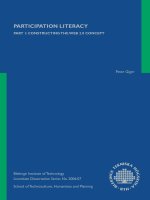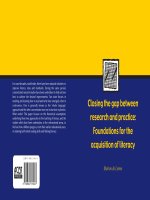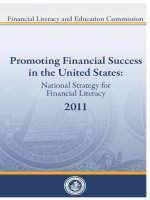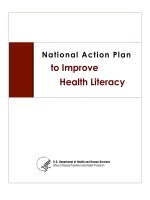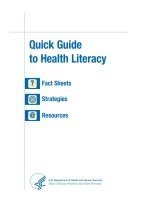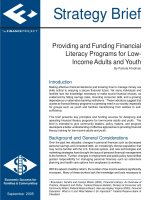121_DisciplineSpecific Literacy
Bạn đang xem bản rút gọn của tài liệu. Xem và tải ngay bản đầy đủ của tài liệu tại đây (1.67 MB, 40 trang )
Discipline-Specific
Literacy
Module 3
Mathematics
1
Discipline-Specific
Literacy
5-3-1.
On your own, identify 5 key
ideas, principles or facts.
In pairs, share your list and come
up with your top 3.
At your table, or with another
pair, identify 1 “MVP” (most
valuable point)
2
Essential Questions
• How can utilizing discipline specific reading
strategies to enhance the understanding of all
students within the mathematics discipline?
• How does literacy across the disciplines prepare
students for their next educational challenges?
• How do we prepare students to Read Like
Mathematicians?
3
Why Literacy is a Shared
Responsibility
8th Grade: Only one third were able to
perform at a proficient level involving more
sophisticated disciplinary comprehension
expectations. Only 3% scored advanced.
12th Grade: Only 5% scored at advanced
levels, able to read specialized and complex
texts.
NAEP, 2009
4
Why Literacy in Math?
“21st Century literacy demands that students
need to be proficient readers in a variety of
types of texts. Students need frequent
opportunities to read and write and quality
instruction as part of their learning experience.”
•Irvin, Judith, Meltzer, Julie & Dukes, Melinda (2007) Taking Action of Adolescent
•Literacy an Implementation Guide for School Leaders. International Reading
•Association. 51
5
3 Shifts
6 Shifts
1. Building knowledge through PK-5, Balance of informational
content-rich literary nonfiction and literary text
and informational texts.
6-12, Building knowledge in the
disciplines
2. Reading and writing grounded
in evidence from text.
Text-based answers
Writing to/from sources
3. Regular practice with complex
text and its academic vocabulary.
Staircase of complexity
Academic vocabulary
6
CCSS Reading Informational
(Grade 5)
CCSS Reading Standards for
Literacy in Science & Technical
Subjects (Grades 6-8)
7. Draw on information from multiple
print or digital sources, demonstrating
the ability to locate an answer to a
question quickly or to solve a problem
efficiently. 5RI7
7. Integrate quantitative or technical
information expressed in words in a text
with a version of that information
expressed visually (e.g., in a flowchart,
diagram, model, graph, or table). 68RS/TS7
8. Explain how an author uses reasons
and evidence to support particular
points in a text, identifying which
reasons and evidence support which
point(s). 5RI8
8. Distinguish among facts, reasoned
judgment based on research findings,
and speculation in a text.
6-8RS/TS8
9. Integrate information from several texts 9. Compare and contrast the information
on the same topic in order to write or
gained from experiments, simulations,
speak about the subject knowledgeably.
video, or multimedia sources with that
5RI9
gained from reading a text on the same
topic. 6-8RS/TS9
10. By the end of the year, read and
comprehend informational texts,
including history/social studies, science,
and technical texts, at the high end of
the grades 4-5 text complexity band
independently and proficiently. 5RI10
10.By the end of grade 8, read and
comprehend science/technical texts in
the grades 6-8 text complexity band
independently and proficiently.
6-8RS/TS10
7
CCSS Reading Informational
(Grade 5)
CCSS Reading Standards for
Literacy in Science & Technical
Subjects (Grades 6-8)
7. Draw on information from multiple
print or digital sources, demonstrating
the ability to locate an answer to a
question quickly or to solve a problem
efficiently. 5RI7
7. Integrate quantitative or technical
information expressed in words in a text
with a version of that information
expressed visually (e.g., in a flowchart,
diagram, model, graph, or table). 68RS/TS7
8. Explain how an author uses reasons
and evidence to support particular
points in a text, identifying which
reasons and evidence support which
point(s). 5RI8
8. Distinguish among facts, reasoned
judgment based on research findings,
and speculation in a text.
6-8RS/TS8
9. Integrate information from several texts 9. Compare and contrast the information
on the same topic in order to write or
gained from experiments, simulations,
speak about the subject knowledgeably.
video, or multimedia sources with that
5RI9
gained from reading a text on the same
topic. 6-8RS/TS9
10. By the end of the year, read and
comprehend informational texts,
including history/social studies, science,
and technical texts, at the high end of
the grades 4-5 text complexity band
independently and proficiently. 5RI10
10.By the end of grade 8, read and
comprehend science/technical texts in
the grades 6-8 text complexity band
independently and proficiently.
6-8RS/TS10
8
CCSS Reading Informational
(Grade 5)
CCSS Reading Standards for
Literacy in Science & Technical
Subjects (Grades 6-8)
7. Draw on information from multiple
print or digital sources, demonstrating
the ability to locate an answer to a
question quickly or to solve a problem
efficiently. 5RI7
7. Integrate quantitative or technical
information expressed in words in a text
with a version of that information
expressed visually (e.g., in a flowchart,
diagram, model, graph, or table). 68RS/TS7
8. Explain how an author uses reasons
and evidence to support particular
points in a text, identifying which
reasons and evidence support which
point(s). 5RI8
8. Distinguish among facts, reasoned
judgment based on research findings,
and speculation in a text.
6-8RS/TS8
9. Integrate information from several texts 9. Compare and contrast the information
on the same topic in order to write or
gained from experiments, simulations,
speak about the subject knowledgeably.
video, or multimedia sources with that
5RI9
gained from reading a text on the same
topic. 6-8RS/TS9
10. By the end of the year, read and
comprehend informational texts,
including history/social studies, science,
and technical texts, at the high end of
the grades 4-5 text complexity band
independently and proficiently. 5RI10
10.By the end of grade 8, read and
comprehend science/technical texts in
the grades 6-8 text complexity band
independently and proficiently.
6-8RS/TS10
9
Math & Literacy
Mixing it Up!
The goal is to give
students literacy
tasks and instruction
that best supports math
not distract from it.
•Taking Action of Adolescent Literacy, 54
10
Mathematical Literacy –
More than just vocabulary
The National Council of Teachers of
Mathematics (NCTM), the New York State
Standards, and the Partnership for 21st
Century Skills present
communication
-the ability to use language to express
mathematical ideas precisely-
as a vital skill for all students in
mathematics.
11
“Effective vocabulary instruction does not
rely on definitions, students must represent
their knowledge of words in linguistic and
nonlinguistic ways…”
Students gradually gain word meaning
through:
•Multiple exposures
•Discussion of terms they are learning
Marzano, 2004; Marzano & Pickering, 2005
12
Simplifying the language is not
always better…
Read these numbers…
1/3
2.07
13
Implement these ideas, right away!
HOW? …Encourage students to:
Use math words vs. “nonmath” words
Answer in complete sentences
Verbally explain their answers/processes
Keep a personal math word wall
Become the expert of a mathematical
word (describe, visually represent, act
out, categorize, and share)
14
Disciplinary Reading
• Specialized skills and activities
• Idea is to consider the learning demands
of subject matter
• Example: text is essential
– Pictures differ in their role
– Technical drawings
– Information may be descriptive, sequential,
relational, hierarchical, causal
15
According to Langer (2011), “subject-area
teachers, who are disciplinary experts, need to
guide, model, and provide opportunities for
students to try out and step into the ways of
thinking that are appropriate to that discipline”
As teachers invite students to become learners
in academic disciplines, they need to provide
discipline-specific strategy instruction,
increased opportunities to read, differentiated
reading materials, and literacy assessment.
16
Reading Like a Mathematician
• As a mathematician, what strategies do
you use to access and read math
problems and texts?
17
Sample literacy tasks for
mathematics students:
• Understand processes
• Grasp abstract concepts and translate
them into symbols
• Distinguish patterns
• Decode words and numeric and
nonnumeric symbols
• Translate words into problems and
problems into words
• Use journals to write about and examine
ideas and reflect on solutions
• Write paragraphs to compare key
concepts, such as a line and a plane
18
Placemat Activity
On the chart paper…
•Individually list ideas and strategies you
use to help students read text in your
mathematics classroom.
•With your table group decide which
strategies you find to be most successful in
a mathematics classroom.
19
Place Mat Activity : Math Strategies
20
Placemat Activity
On the chart paper…
•Individually list ideas and strategies you
use to help students read text in your
mathematics classroom.
•With your table group decide which
strategies you find to be most successful in
a mathematics classroom.
21
22
Math Class Needs a Makeover
• http://
www.ted.com/talks/dan_meyer_math_curr
iculum_makeover.html
• As you watch this video, please write
some “Aha’s” and “Hmmm?s” so share
with the group.
23
Standards for Mathematical
Practices
• “Describe varieties of expertise that
mathematics educators should seek to
develop in their students.”
• “Rest on important processes and
proficiencies in longstanding importance
in mathematics education.”
• Are not WHAT you teach, but rather HOW
you teach.
24
The 8 Standards of Mathematical
Practice
25
